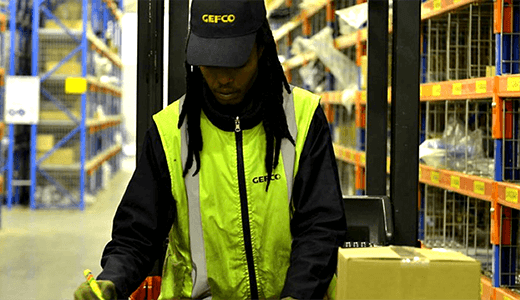Gefco’s SYNCHRO hub is using connected technology and AI to optimise service parts inventory and distribution, writes Karen McCandless
 Connected cars are set to hit the mainstream: market penetration is expected to soar from 38.9% in 2018 to 80.7% in 2022, according to statistics provider Statista, which will have a significant impact for logistics companies working in the aftersales market.
Connected cars are set to hit the mainstream: market penetration is expected to soar from 38.9% in 2018 to 80.7% in 2022, according to statistics provider Statista, which will have a significant impact for logistics companies working in the aftersales market.
In particular, connected cars are paving the way for predictive maintenance, which offers additional challenges and opportunities for spare parts deliveries.
Traditionally, when a car breaks down, the driver takes it to an independent repair centre or dealership, where mechanics diagnose the problem, order the spare part, and fix the car when the part arrives.
With connected cars, the process is faster, and driven by the dealership. Through over-the-air connectivity, dealers can remotely monitor the state of the car. They can find out early if there is a potential problem, diagnose it, arrange a day and time for the driver to bring their car in, and then order the faulty part in advance so it is ready and waiting when the customer does so.
Dealership logistics
While this type of predictive maintenance is not new, it has an impact on the dealership’s logistics provider who has to react to these demands, making sure there is the correct stock level in the warehouse to allow delivery of the part in time for the customer’s appointment.
This means a step change for automotive logistics companies such as Gefco, which have not traditionally operated in this manner.
Vincent Delamare, market line manager, car manufacturers at the logistics service provider, explains that the traditional process involved the company distributing spare parts on an overnight basis.
“A dealer placed an order with its brand central warehouse before 16.00 or 17.00 on any given day. This order was then processed in the central warehouse and shipped overnight, with the aim of delivering it before 08.00-09.00 the next morning,” he says.
The problem with this, according to Delamare, is that it’s a reactive situation: in such operations, a dealer will only order or receive parts when a car is already in their garage waiting to be fixed, which means the customer has to wait longer.
However, if the dealer has already diagnosed a problem in a car, or predicts that a certain part is going to fail, then stock can be ordered in advance so it is ready and waiting.
“When we get this extra lead time and visibility into orders, we can get the parts to the dealership before the customer arrives for their appointment, so their car gets fixed quicker,” says Delamare.
Better stock management
This has a direct impact on stock management for the dealer, as they can order parts in advance and be sure they will arrive in time, removing the need to maintain a large stock of spare parts themselves.
“Dealerships can get rid of their in-house stock, which allows them to create additional maintenance bases from this extra space, so they can repair more cars every day,” says Delamare.
According to Delamare, this provides a competitive differentiator for OEMs and their dealerships, allowing them to provide extra customer service in the aftersales market and giving them an edge over independent, third-party mechanics, as well as e-commerce companies such as Amazon.
It also means that logistics providers can better manage their own stock, as they have a better idea of what orders they are expected to fulfil, with fewer rush jobs and fewer orders for general stock to be held in the warehouse. It improves fulfilment and picking.
“We can go leaner on stock, and improve filling ratios,” says Delamare.

New type of logistics management
To successfully execute this strategy of scheduling appointments on a predictive basis, dealerships have to be sure they can rely on their spare parts providers and logistics partners to deliver the parts when they need them, so they are ready for the appointments.
This requires more (and more frequent) deliveries, as dealerships still have to work on other, non-predictive maintenance jobs. These jobs can include planned maintenance, regular problems and urgent jobs.
Helping to enable this is a logistics service from Gefco called SYNCHRO Hub, which is based on a series of connected local distribution centres in high density geographical areas within 50km of dealerships. These warehouses can stock parts from multiple OEMs and are fed information about orders directly from the central warehouse.
“These warehouses can deliver up to three times a day, not just to the dealership, but also to drop-off points such as parcel shops and lockers and even a car owner’s home, working in a similar way to Amazon pick-up points,” says Delamare. “If an order is placed at 09.00, we can ship it by 11.00, instead of delivering it the next day. Dealerships can extend the working hours of their workshops due to the possibilities of extra stock delivery provided by these local distribution centres. The warehouses are also able to stock a wider range of products, as requested by OEMs and dealerships.”
Overcoming predictive challenges
SYNCHRO Hub also helps Gefco to overcome the logistics challenges of knowing how much stock to keep in its warehouses, and the right availability ratio. Using artificial intelligence, Gefco can more accurately predict a dealership’s consumption of parts to ensure they know the minimum amount of stock they should hold.
“Using predictive analytics based not only on a dealership’s past consumption but also discussions with dealers and independent retailers, as well as seasonal factors such as how tyre and battery use differs at certain times of the year, we can better anticipate requests and ensure we have the right stock to fulfill them,” says Delamare. “This communication with the dealers also helps us understand when we might need to increase our stock levels, as we know when they are running promotional campaigns that might increase requests, as well as other factors that influence parts demands.”
Gefco also works closely with the dealerships to keep an eye on current and anticipated future trends that will influence demand for certain parts. For example, the ‘dieselgate’ emissions scandal influenced the volume of diesel cars being bought, with a knock-on effect on demand for certain spares.
Another example is the increase in demand for SUVs, which made up 32.4% of total global car sales in 2017, up 12.7% compared with 2016, according to automotive business intelligence solutions provider, JATO.
“We watch these kinds of global trends and events closely, but the question we also have to consider is when it will hit consumption of new parts,” says Delamare. “We can see that more and more SUVs are being purchased, for example, but when will that translate into a higher demand for new parts for these types of cars?”
This is also true in the case of recalls, when a manufacturer has found that a part is defective. Gefco relies on its analytics capabilities to ensure it can work out what the demand for new parts will be as fast as possible.
“We need to have the most efficient delivery methods possible in place for when this happens,” says Delamare. “This is where the SYNCHRO Hub comes in, as we can more quickly get these parts to dealers or independent mechanics in these kinds of extraordinary situations.”
Future developments
While logistics services such as SYNCHRO Hub will help with more efficient parts deliveries and thus enable predictive maintenance for connected cars, there are still aspects of the process that have to be worked out. This requires close collaboration between OEMs, dealerships and logistics providers.
“Our logistics platform needs to be able to communicate with OEMs’ IT systems so we can access crucial information to help us ensure adequate stock levels in local distribution systems, and enable us to fulfil orders in a timely manner,” says Delamare. “Some OEMs want to use our systems, some want to use their own – but whatever the case, the information needs to be able to flow seamlessly.”
Faster, more frequent and more convenient parts deliveries will help logistics providers and OEMs compete against Amazon, which is already trying to take market share by delivering generic parts directly to customers’ homes or pick-up points. However, OEMs and dealerships need to work out a strategy to let them make the most of logistics services such as SYNCHRO Hub.
“Change is never easy, and the automotive industry is no exception,” says Delamare. “OEMs and dealerships need to work out a strategy to help them take advantage of the new logistics and delivery options and make changes to the way they operate. This could be getting rid of stock they hold, offering more services, increasing opening hours, or setting up more maintenance space to enable them to fix more cars.
“We also need to help support our customers’ networks by explaining how SYNCHRO Hub works, as well as in taking the fight to competitors and e-commerce disruptors by providing track and trace APIs [application programming interfaces] to feed our customers’ websites, making them as easy to use as Amazon’s.”
 “OEMs and dealerships need to work out a strategy to help them take advantage of the new logistics and delivery options and make changes to the way they operate. This could be getting rid of stock they hold, offering more services, increasing opening hours, or setting up more maintenance space to enable them to fix more cars.” - Vincent Delamare, Gefco
“OEMs and dealerships need to work out a strategy to help them take advantage of the new logistics and delivery options and make changes to the way they operate. This could be getting rid of stock they hold, offering more services, increasing opening hours, or setting up more maintenance space to enable them to fix more cars.” - Vincent Delamare, Gefco

























![Global[1]](https://d3n5uof8vony13.cloudfront.net/Pictures/web/a/d/s/global1_726550.svgz)












